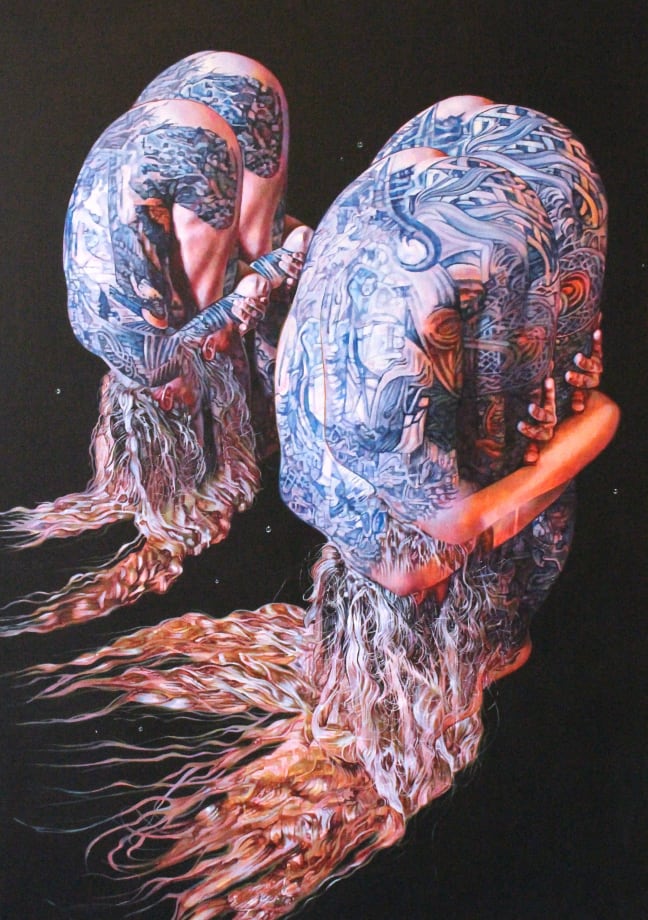Sarah Muirhead: A Ghost Only You Can Name (Pt 1)
What kind of love survives in thought?
What sort of truth remains once a moment is made beautiful?
Sarah Muirhead builds paintings on the unstable ground of memory. The brief, flickering moments we return to again and again, until they become something else.
A myth. An echo. A ghost only you can name.
Known for her psychologically intense, voyeuristic-toned portraiture, Muirhead moves away from the face here to explore the body in fragments. The focus shifts to hands, feet and jewellery - details that carry the haunting weight of scenes we return to.
Her work is less about portraying people as they were, but about how they linger in the mind: dramatised, distorted, and embellished - made sacred in their retelling.
She constructs these visions - part truth and longing - as perhaps more vivid in recollection than in life. The act of painting, like remembering, becomes sanctified not because it reveals truth, but because of the care and attention it requires.
The devotional quality throughout this work is not strictly religious. Still, it borrows the aesthetic language of reverence, evident in elements such as chandeliers, glowing skin, and sacred gestures. Yet, this is devotion laced with humour and self-awareness, flirting with the distant cousins of kitsch and fetish. It straddles the line between tenderness and distance; vulnerability and performance. Somewhere between a church and a nightclub.
Throughout, Muirhead openly embraces the unreliability of the narrator and the performative nature of painting. Her compositions are densely packed and charged with imposed symbolism of layered tattoos, drips, and ornamental detail - a deliberate signal from the artist that what we are seeing is not 'real'.
We must remember that what she offers is not truth, but ritual. Her gaze is loving, but never neutral. To be painted or remembered is to be changed, and she knows it.
Alongside these figurative works are Muirhead's graphite disaster drawings - detailed, apocalyptic landscapes devoid of figures but rich in emotional charge. Referencing Babel-like towers and impossible structures, they visualise a kind of internal collapse as external ruin. Tumbling relics of a human's presence - they are counterpoints to the personal intensity of the paintings: vast and strangely calm.
We've all built altars to what never quite was - a glitch in time we've mistaken for fact. Here, we are invited to see remembering as a kind of making. To revel in the seriousness of small, strange moments; to confess to the absurdity of caring so much about what is already gone. In doing so, Muirhead doesn't offer resolution, but something more generous: a space for projection, recognition and return.
In painting, she says: I saw you. Even if you didn't see me back.
What does it mean to build an altar when you're not sure who - or what - you're worshipping? Muirhead suggests that the act of building is enough.
WORDS BY Mollie Barnes, independent curator
For SALES & PRESS enquiries
-
 Catastrophe, 2023Framed, graphite on paper84 x 59 cm
Catastrophe, 2023Framed, graphite on paper84 x 59 cm
33.1 x 23.2 in -
 Chandelier, 2025Acrylic on wood panel42 x 29.5 cm
Chandelier, 2025Acrylic on wood panel42 x 29.5 cm
16.5 x 11.6 in -
 Disaster Drawing, 2023Framed, graphite on paper84 x 59 cm
Disaster Drawing, 2023Framed, graphite on paper84 x 59 cm
33.1 x 23.2 in -
 Foot Portrait 1, 2025Acrylic on wood panel41 x 30 cm
Foot Portrait 1, 2025Acrylic on wood panel41 x 30 cm
16.1 x 11.8 in -
 Foot Portrait 2, 2025Acrylic on wood panel21 x 29.7 cm
Foot Portrait 2, 2025Acrylic on wood panel21 x 29.7 cm
8.3 x 11.7 in -
 Foot Portrait 3, 2025Acrylic on wood panel21 x 29.7 cm
Foot Portrait 3, 2025Acrylic on wood panel21 x 29.7 cm
8.3 x 11.7 in -
 Foot Portrait 4, 2025Acrylic on wood panel29.5 x 21 cm
Foot Portrait 4, 2025Acrylic on wood panel29.5 x 21 cm
11.6 x 8.3 in -
 Gaze Back, 2025Acrylic on wood panel59 x 42 cm
Gaze Back, 2025Acrylic on wood panel59 x 42 cm
23.2 x 16.5 in -
 I Saw, 2025Acrylic on linen110 x 80 cm
I Saw, 2025Acrylic on linen110 x 80 cm
43.3 x 31.5 in -
 JC, 2025Acrylic on canvas60 x 60 cm
JC, 2025Acrylic on canvas60 x 60 cm
23.6 x 23.6 in -
 Love Bird, 2023Acrylic on wooden panel30 x 21 x 3 cm
Love Bird, 2023Acrylic on wooden panel30 x 21 x 3 cm
11.8 x 8.3 x 1.2 in -
 Oracle, 2025Acrylic on canvas84 x 60 cm
Oracle, 2025Acrylic on canvas84 x 60 cm
33.1 x 23.6 in -
 Pause, 2025Acrylic on wood panel42 x 29.5 cm
Pause, 2025Acrylic on wood panel42 x 29.5 cm
16.5 x 11.6 in -
 Protect, 2025Acrylic on wood panel29.5 x 21 cm
Protect, 2025Acrylic on wood panel29.5 x 21 cm
11.6 x 8.3 in -
 Queen Velveteen, 2025Acrylic on linen76 x 61 cm
Queen Velveteen, 2025Acrylic on linen76 x 61 cm
29.9 x 24 in -
 Self, 2025Graphite on paper83 x 59 cm
Self, 2025Graphite on paper83 x 59 cm
32.7 x 23.2 in -
 Shift, 2025Acrylic on canvas83 x 59 cm
Shift, 2025Acrylic on canvas83 x 59 cm
32.7 x 23.2 in -
 Shine, 2025Acrylic on canvas70 x 70 cm
Shine, 2025Acrylic on canvas70 x 70 cm
27.6 x 27.6 in -
 Talisman, 2025Acrylic on wood panel50 x 50 cm
Talisman, 2025Acrylic on wood panel50 x 50 cm
19.7 x 19.7 in -
 Taste, 2025Acrylic on wood panel29.5 x 21 cm
Taste, 2025Acrylic on wood panel29.5 x 21 cm
11.6 x 8.3 in -
 Touch, 2025Acrylic on canvasDiameter 60 cm / 24 in
Touch, 2025Acrylic on canvasDiameter 60 cm / 24 in























